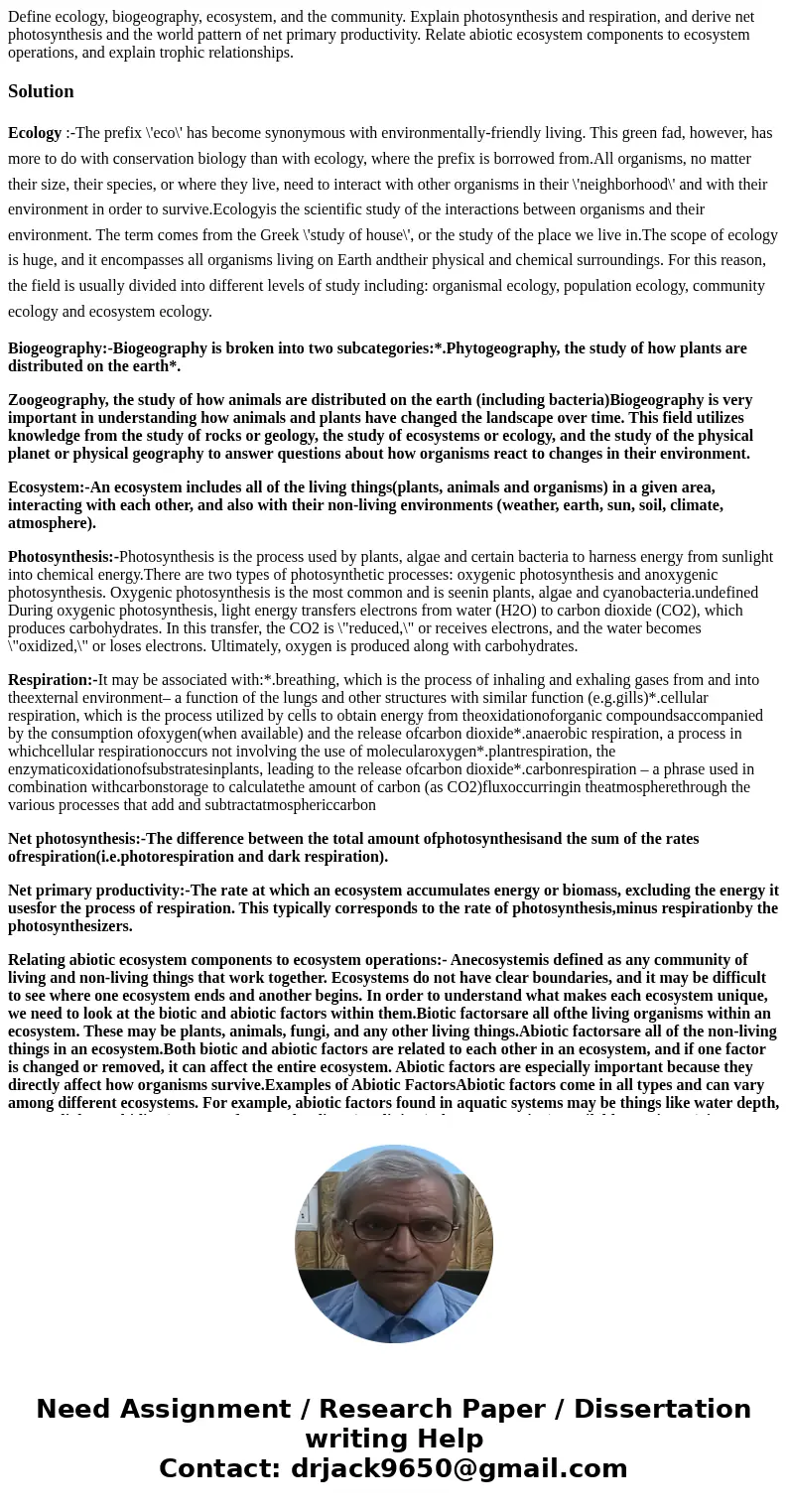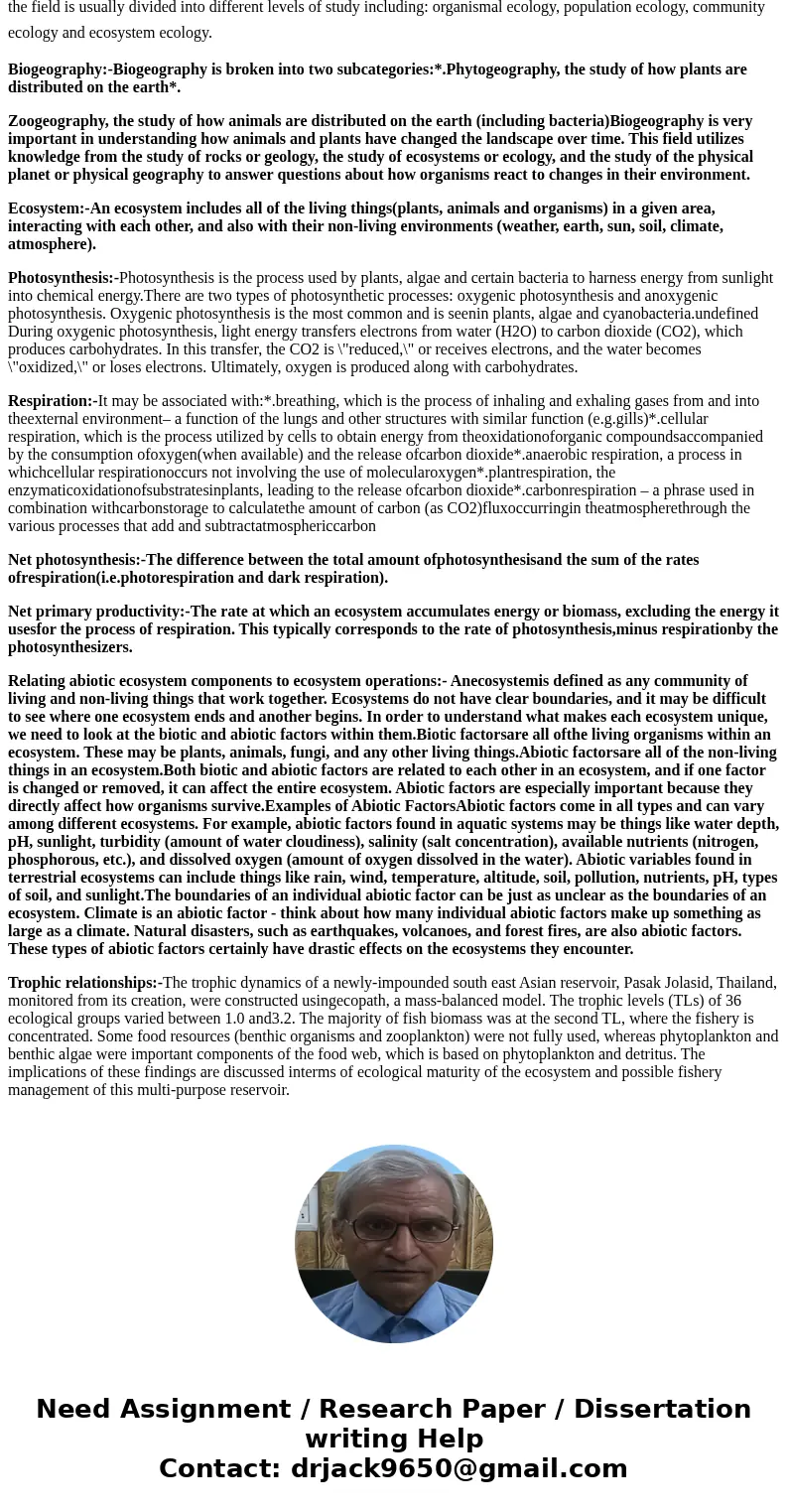Define ecology biogeography ecosystem and the community Expl
Solution
Ecology :-The prefix \'eco\' has become synonymous with environmentally-friendly living. This green fad, however, has more to do with conservation biology than with ecology, where the prefix is borrowed from.All organisms, no matter their size, their species, or where they live, need to interact with other organisms in their \'neighborhood\' and with their environment in order to survive.Ecologyis the scientific study of the interactions between organisms and their environment. The term comes from the Greek \'study of house\', or the study of the place we live in.The scope of ecology is huge, and it encompasses all organisms living on Earth andtheir physical and chemical surroundings. For this reason, the field is usually divided into different levels of study including: organismal ecology, population ecology, community ecology and ecosystem ecology.
Biogeography:-Biogeography is broken into two subcategories:*.Phytogeography, the study of how plants are distributed on the earth*.
Zoogeography, the study of how animals are distributed on the earth (including bacteria)Biogeography is very important in understanding how animals and plants have changed the landscape over time. This field utilizes knowledge from the study of rocks or geology, the study of ecosystems or ecology, and the study of the physical planet or physical geography to answer questions about how organisms react to changes in their environment.
Ecosystem:-An ecosystem includes all of the living things(plants, animals and organisms) in a given area, interacting with each other, and also with their non-living environments (weather, earth, sun, soil, climate, atmosphere).
Photosynthesis:-Photosynthesis is the process used by plants, algae and certain bacteria to harness energy from sunlight into chemical energy.There are two types of photosynthetic processes: oxygenic photosynthesis and anoxygenic photosynthesis. Oxygenic photosynthesis is the most common and is seenin plants, algae and cyanobacteria.undefined During oxygenic photosynthesis, light energy transfers electrons from water (H2O) to carbon dioxide (CO2), which produces carbohydrates. In this transfer, the CO2 is \"reduced,\" or receives electrons, and the water becomes \"oxidized,\" or loses electrons. Ultimately, oxygen is produced along with carbohydrates.
Respiration:-It may be associated with:*.breathing, which is the process of inhaling and exhaling gases from and into theexternal environment– a function of the lungs and other structures with similar function (e.g.gills)*.cellular respiration, which is the process utilized by cells to obtain energy from theoxidationoforganic compoundsaccompanied by the consumption ofoxygen(when available) and the release ofcarbon dioxide*.anaerobic respiration, a process in whichcellular respirationoccurs not involving the use of molecularoxygen*.plantrespiration, the enzymaticoxidationofsubstratesinplants, leading to the release ofcarbon dioxide*.carbonrespiration – a phrase used in combination withcarbonstorage to calculatethe amount of carbon (as CO2)fluxoccurringin theatmospherethrough the various processes that add and subtractatmosphericcarbon
Net photosynthesis:-The difference between the total amount ofphotosynthesisand the sum of the rates ofrespiration(i.e.photorespiration and dark respiration).
Net primary productivity:-The rate at which an ecosystem accumulates energy or biomass, excluding the energy it usesfor the process of respiration. This typically corresponds to the rate of photosynthesis,minus respirationby the photosynthesizers.
Relating abiotic ecosystem components to ecosystem operations:- Anecosystemis defined as any community of living and non-living things that work together. Ecosystems do not have clear boundaries, and it may be difficult to see where one ecosystem ends and another begins. In order to understand what makes each ecosystem unique, we need to look at the biotic and abiotic factors within them.Biotic factorsare all ofthe living organisms within an ecosystem. These may be plants, animals, fungi, and any other living things.Abiotic factorsare all of the non-living things in an ecosystem.Both biotic and abiotic factors are related to each other in an ecosystem, and if one factor is changed or removed, it can affect the entire ecosystem. Abiotic factors are especially important because they directly affect how organisms survive.Examples of Abiotic FactorsAbiotic factors come in all types and can vary among different ecosystems. For example, abiotic factors found in aquatic systems may be things like water depth, pH, sunlight, turbidity (amount of water cloudiness), salinity (salt concentration), available nutrients (nitrogen, phosphorous, etc.), and dissolved oxygen (amount of oxygen dissolved in the water). Abiotic variables found in terrestrial ecosystems can include things like rain, wind, temperature, altitude, soil, pollution, nutrients, pH, types of soil, and sunlight.The boundaries of an individual abiotic factor can be just as unclear as the boundaries of an ecosystem. Climate is an abiotic factor - think about how many individual abiotic factors make up something as large as a climate. Natural disasters, such as earthquakes, volcanoes, and forest fires, are also abiotic factors. These types of abiotic factors certainly have drastic effects on the ecosystems they encounter.
Trophic relationships:-The trophic dynamics of a newly-impounded south east Asian reservoir, Pasak Jolasid, Thailand, monitored from its creation, were constructed usingecopath, a mass-balanced model. The trophic levels (TLs) of 36 ecological groups varied between 1.0 and3.2. The majority of fish biomass was at the second TL, where the fishery is concentrated. Some food resources (benthic organisms and zooplankton) were not fully used, whereas phytoplankton and benthic algae were important components of the food web, which is based on phytoplankton and detritus. The implications of these findings are discussed interms of ecological maturity of the ecosystem and possible fishery management of this multi-purpose reservoir.


 Homework Sourse
Homework Sourse